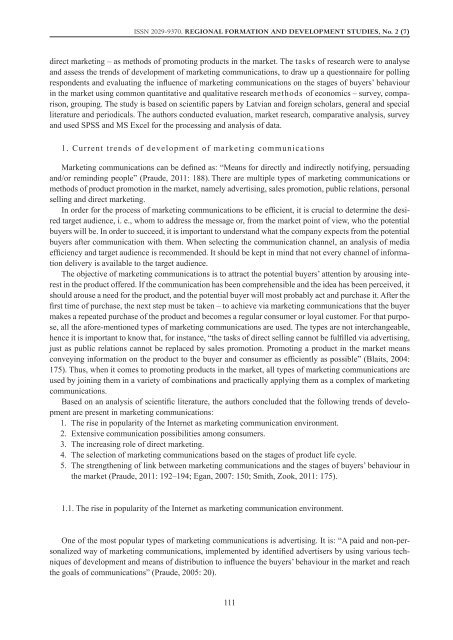regional formation and development studies - KlaipÄdos universitetas
regional formation and development studies - KlaipÄdos universitetas
regional formation and development studies - KlaipÄdos universitetas
Create successful ePaper yourself
Turn your PDF publications into a flip-book with our unique Google optimized e-Paper software.
ISSN 2029-9370. Regional Formation <strong>and</strong> Development Studies, No. 2 (7)<br />
direct marketing – as methods of promoting products in the market. The tasks of research were to analyse<br />
<strong>and</strong> assess the trends of <strong>development</strong> of marketing communications, to draw up a questionnaire for polling<br />
respondents <strong>and</strong> evaluating the influence of marketing communications on the stages of buyers’ behaviour<br />
in the market using common quantitative <strong>and</strong> qualitative research methods of economics – survey, comparison,<br />
grouping. The study is based on scientific papers by Latvian <strong>and</strong> foreign scholars, general <strong>and</strong> special<br />
literature <strong>and</strong> periodicals. The authors conducted evaluation, market research, comparative analysis, survey<br />
<strong>and</strong> used SPSS <strong>and</strong> MS Excel for the processing <strong>and</strong> analysis of data.<br />
1. Current trends of <strong>development</strong> of marketing communications<br />
Marketing communications can be defined as: “Means for directly <strong>and</strong> indirectly notifying, persuading<br />
<strong>and</strong>/or reminding people” (Praude, 2011: 188). There are multiple types of marketing communications or<br />
methods of product promotion in the market, namely advertising, sales promotion, public relations, personal<br />
selling <strong>and</strong> direct marketing.<br />
In order for the process of marketing communications to be efficient, it is crucial to determine the desired<br />
target audience, i. e., whom to address the message or, from the market point of view, who the potential<br />
buyers will be. In order to succeed, it is important to underst<strong>and</strong> what the company expects from the potential<br />
buyers after communication with them. When selecting the communication channel, an analysis of media<br />
efficiency <strong>and</strong> target audience is recommended. It should be kept in mind that not every channel of in<strong>formation</strong><br />
delivery is available to the target audience.<br />
The objective of marketing communications is to attract the potential buyers’ attention by arousing interest<br />
in the product offered. If the communication has been comprehensible <strong>and</strong> the idea has been perceived, it<br />
should arouse a need for the product, <strong>and</strong> the potential buyer will most probably act <strong>and</strong> purchase it. After the<br />
first time of purchase, the next step must be taken – to achieve via marketing communications that the buyer<br />
makes a repeated purchase of the product <strong>and</strong> becomes a regular consumer or loyal customer. For that purpose,<br />
all the afore-mentioned types of marketing communications are used. The types are not interchangeable,<br />
hence it is important to know that, for instance, “the tasks of direct selling cannot be fulfilled via advertising,<br />
just as public relations cannot be replaced by sales promotion. Promoting a product in the market means<br />
conveying in<strong>formation</strong> on the product to the buyer <strong>and</strong> consumer as efficiently as possible” (Blaits, 2004:<br />
175). Thus, when it comes to promoting products in the market, all types of marketing communications are<br />
used by joining them in a variety of combinations <strong>and</strong> practically applying them as a complex of marketing<br />
communications.<br />
Based on an analysis of scientific literature, the authors concluded that the following trends of <strong>development</strong><br />
are present in marketing communications:<br />
1. The rise in popularity of the Internet as marketing communication environment.<br />
2. Extensive communication possibilities among consumers.<br />
3. The increasing role of direct marketing.<br />
4. The selection of marketing communications based on the stages of product life cycle.<br />
5. The strengthening of link between marketing communications <strong>and</strong> the stages of buyers’ behaviour in<br />
the market (Praude, 2011: 192–194; Egan, 2007: 150; Smith, Zook, 2011: 175).<br />
1.1. The rise in popularity of the Internet as marketing communication environment.<br />
One of the most popular types of marketing communications is advertising. It is: “A paid <strong>and</strong> non-personalized<br />
way of marketing communications, implemented by identified advertisers by using various techniques<br />
of <strong>development</strong> <strong>and</strong> means of distribution to influence the buyers’ behaviour in the market <strong>and</strong> reach<br />
the goals of communications” (Praude, 2005: 20).<br />
111

















